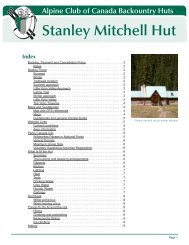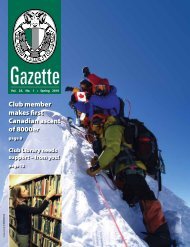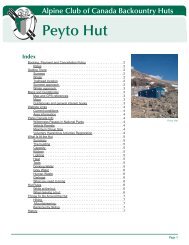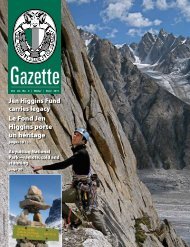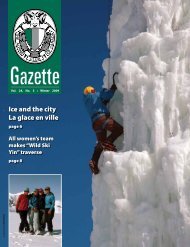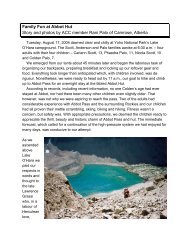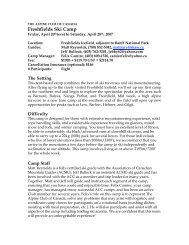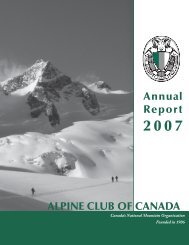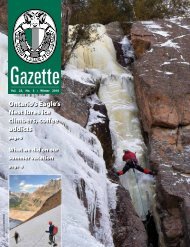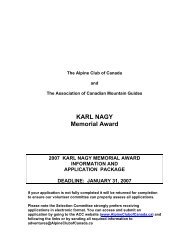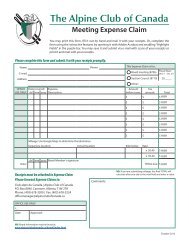A Passion for the Mountains - The Alpine Club of Canada
A Passion for the Mountains - The Alpine Club of Canada
A Passion for the Mountains - The Alpine Club of Canada
Create successful ePaper yourself
Turn your PDF publications into a flip-book with our unique Google optimized e-Paper software.
Water Wellness in <strong>the</strong><br />
Backcountry<br />
by Ola Dunin-Bell<br />
Samuel<br />
T. Coleridge could<br />
have just as easily<br />
been writing about today’s wilderness<br />
traveler as <strong>the</strong> ancient mariner when he<br />
penned his famous poem in 1797. Water<br />
is vital to all <strong>of</strong> us, but safe potable water is<br />
not always readily accessible. We all know<br />
that water weighs a lot – one kilogram per<br />
litre – and <strong>the</strong> last thing we want to do<br />
is add unnecessary weight to our packs.<br />
Un<strong>for</strong>tunately, dehydration is both subtle<br />
in its onset and serious in its consequences.<br />
If a person waits until <strong>the</strong>y are thirsty to<br />
drink, <strong>the</strong>y have waited too long. With<br />
dehydration come fatigue, muscle cramps<br />
and nausea. Per<strong>for</strong>mance goes down, but<br />
this is not <strong>the</strong> worst <strong>of</strong> it. Dehydration<br />
increases risk <strong>for</strong> heat stroke and can<br />
eventually lead to collapse and even death.<br />
But how much water is enough and how<br />
can we make sure we can get it?<br />
An active person will require<br />
approximately two and a half to three litres<br />
<strong>of</strong> water daily. Add some sunshine, hot<br />
wea<strong>the</strong>r, a refl ective surface such as a rock<br />
face or glacier and four to fi ve litres becomes<br />
<strong>the</strong> minimum daily requirement. Altitude<br />
adds a fur<strong>the</strong>r dimension with <strong>the</strong> air being<br />
much drier <strong>the</strong> higher one ascends. Because<br />
<strong>of</strong> this, signifi cant body water is lost with<br />
every breath taken. If counting litres is not<br />
your thing, you should be drinking enough<br />
that you need to pee several times during<br />
<strong>the</strong> day and your urine is copious and<br />
almost colourless. <strong>The</strong> one caution here is<br />
<strong>for</strong> those individuals involved in endurance<br />
activities (e.g. Ironman triathlon, canyon<br />
walking) where cases <strong>of</strong> excessive fl uid<br />
intake can produce dilution <strong>of</strong> <strong>the</strong> body’s<br />
normal chemistry (hyponatremia), leading<br />
to complications as serious as those seen<br />
in dehydration. For those involved in<br />
prolonged physically demanding activities,<br />
<strong>the</strong> range <strong>of</strong> 500 to 750 ml <strong>of</strong> fl uid intake<br />
per hour has been suggested as more<br />
appropriate and, if possible, in <strong>the</strong> <strong>for</strong>m<br />
<strong>of</strong> sports drinks that include electrolytes<br />
(salts).<br />
As stated earlier, getting your mouth<br />
around this much clean water is not always<br />
easy. Carrying several days’ supply would be<br />
an almost prohibitive weight and not your<br />
fi rst choice unless <strong>the</strong>re was no source along<br />
<strong>the</strong> way. If you are planning a multi-day<br />
20 <strong>Alpine</strong> <strong>Club</strong> <strong>of</strong> <strong>Canada</strong> ● Gazette ● Summer 2003<br />
“Water, water, every where,<br />
Nor any drop to drink.”<br />
excursion up a big wall, hauling<br />
water with you is indeed <strong>the</strong> only<br />
alternative and one you must not<br />
skimp on. Hiking up a mountain<br />
will <strong>of</strong>ten bring you into close<br />
proximity to streams, but although<br />
<strong>the</strong> water may look cool, clear and tempting,<br />
be aware that even in <strong>the</strong> Rocky <strong>Mountains</strong><br />
many <strong>of</strong> <strong>the</strong> streams are contaminated with<br />
organisms that can cause serious illness.<br />
Anyone who has experienced <strong>the</strong><br />
cramping and diarrhea <strong>of</strong> ‘beaver fever’<br />
knows that very quickly, a camping trip<br />
can be ruined and that <strong>of</strong>ten recovery<br />
can be very slow and prolonged, with<br />
fl are ups <strong>of</strong> symptoms even weeks<br />
later. Although cholera is a risk only in<br />
developing countries, E. Coli, salmonella<br />
and shigella are all bacteria that can also<br />
produce life-threatening dysentery (fever<br />
and bloody diarrhea) and can be found in<br />
North American water sources. Infectious<br />
hepatitis, a disease caused by <strong>the</strong> hepatitis A<br />
virus, affects <strong>the</strong> liver producing jaundice as<br />
well as causing nausea, vomiting, fever and<br />
abdominal pain. This tiny virus particle is<br />
frequently spread by water.<br />
At lower elevations a number <strong>of</strong> pathogens<br />
(disease causing organisms), including viruses<br />
(e.g. hepatitis A), bacteria (e.g. salmonella)<br />
and parasites (e.g. cryptosporidium), can<br />
readily be found, but even in upper regions<br />
giardia cysts, <strong>the</strong> source <strong>of</strong> beaver fever, can<br />
be shed into <strong>the</strong> water supply by animals<br />
carrying this parasite. <strong>The</strong> presence <strong>of</strong><br />
animals and humans in an area will mean<br />
faecal contamination and high likelihood<br />
<strong>of</strong> infectious organisms seeding <strong>the</strong> water<br />
supply. Some people are com<strong>for</strong>table with<br />
taking <strong>the</strong> risk <strong>of</strong> drinking unpurifi ed water,<br />
based on <strong>the</strong>ir knowledge <strong>of</strong> <strong>the</strong> local water<br />
supply. To be absolutely certain, however,<br />
some <strong>for</strong>m <strong>of</strong> water treatment is necessary<br />
to eliminate <strong>the</strong> possibility <strong>of</strong> waterborne<br />
illness.<br />
Water Treatment<br />
General principles should be kept in<br />
mind when obtaining water <strong>for</strong> drinking,<br />
even if <strong>the</strong> plan is to proceed with a<br />
disinfection treatment. <strong>The</strong> lower <strong>the</strong> initial<br />
load <strong>of</strong> organisms and o<strong>the</strong>r contaminants,<br />
<strong>the</strong> more effective <strong>the</strong> treatment will be.<br />
Obtain clear, free running water upstream<br />
photo by Josée Larochelle<br />
from any known contamination source,<br />
if taking from a stream, or well out from<br />
shore, with as little silt as possible, if<br />
<strong>the</strong> source is lakewater. Snow should be<br />
collected uphill from <strong>the</strong> hut or campsite<br />
and well away and above any latrine facility.<br />
Avoid any snow nearby or underlying ‘pink<br />
snow’, a <strong>for</strong>m <strong>of</strong> algae seen on glaciers.<br />
Similarly, care should be taken in disposal<br />
<strong>of</strong> waste to avoid contributing fur<strong>the</strong>r to<br />
contamination <strong>of</strong> water supplies. Hand<br />
washing and good personal hygiene are<br />
also key factors in avoiding waterborne<br />
transmission <strong>of</strong> disease.<br />
Disinfection Methods<br />
Water can be made safe <strong>for</strong> drinking<br />
by one <strong>of</strong> three methods – heat, chemical<br />
treatment or mechanical fi ltration.<br />
Heat<br />
Heat is <strong>the</strong> oldest and <strong>the</strong> most<br />
consistently effective method <strong>of</strong> disinfecting<br />
water so that it is safe to drink. Although<br />
old recommendations were to boil water<br />
<strong>for</strong> ten minutes, this has been proven to be<br />
unnecessary and simply bringing it to a boil<br />
allows enough time at high temperature <strong>for</strong><br />
pathogens to be destroyed. Ei<strong>the</strong>r covering<br />
<strong>the</strong> pot after <strong>the</strong> boil and allowing slow<br />
cooling or boiling <strong>for</strong> a full minute provides<br />
a wide safety margin.<br />
Although altitude does lower <strong>the</strong> boiling<br />
temperature, <strong>the</strong> achievable heat is still<br />
enough, but again a longer boiling time,<br />
up to three minutes at high altitude, makes<br />
safety a certainty. <strong>The</strong>re are drawbacks,<br />
however, to heat treatment, <strong>the</strong> main one<br />
being <strong>the</strong> need to carry fuel. Heating<br />
water also does not improve o<strong>the</strong>r physical<br />
characteristics, including appearance and<br />
taste that may make water less palatable.<br />
In <strong>the</strong> next issue chemical treatment<br />
and mechanical methods <strong>for</strong> water<br />
purifi cation will be described.<br />
Ola Dunin-Bell is a Physician and<br />
member <strong>of</strong> <strong>the</strong> Wilderness Medical Society



